L2: transport in plants
1/70
There's no tags or description
Looks like no tags are added yet.
Name | Mastery | Learn | Test | Matching | Spaced |
|---|
No study sessions yet.
71 Terms
what classifies a plant?
chloroplast: plants seen as green
roots present
evolution: based on common ancestry/ phylogeny
ways of transporting water (4)
forces regulating water movement
structure and function: the path of water through a vascular plant
mechanisms of water transport
experimental evidence for the cohesion- tension theory
vascular plant: plant that has specialized vascular tissues (xylem and phloem) to transport water/ nutrients/ food, structural support for them to grow complez & large
cohesion- tension theory: explanation how water moves upward through xylem in plants
vascular plant
plant that has specialized vascular tissues (xylem and phloem) to transport water/ nutrients/ food, structural support for them to grow complex & large
plant vascular tissues (2 main)
plant vascular tissues: specialized tissues in vascular plants that transport water, nutrients, and organic cmps throughout the plant. They also provide structural support
xylem
phloem
(1) vascular tissue: xylem
vascular tissue
transports H2O
roots —> shoots
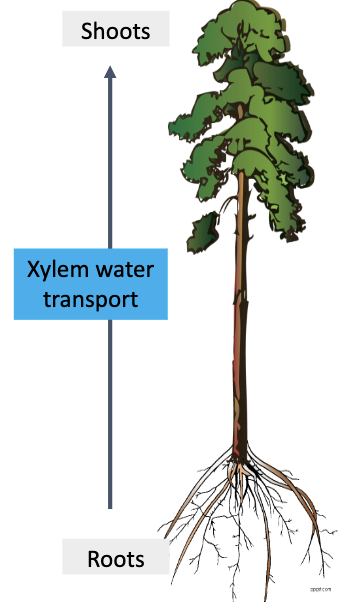
stomata/ stomatal pore
tiny pores
regulate gas exchange at the leaves
water vapour diffuses from leaves and exits —> atmosphere
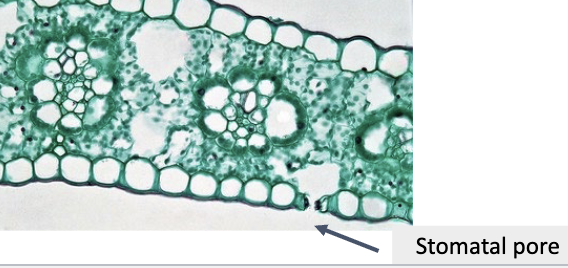
(2) vascular tissue: phloem
vascular tissue
transports sugars (sucrose)
bidirectional (depends on source/site)
(1) ways of transporting water: forces of regulating water movement
water potential energy resulting from
Differences in solute concentration
physical pressure
can predict direction of water movement
water potential
what is it? pure water vs solutions? equation? how to know directionality?
potential energy of water: Ψ (psi)
in a particular env, compared to PE of pure water @ atmospheric pressure and room temp
pure water Ψ= 0 MPa
solutions Ψ<0 MPa (-ve values)
equation:
Water potential (Ψ) = solute (osmotic) potential (Ψs) + pressure potential (Ψp )
know directionality
look @/ calculate Ψ for two environments, H2O moves towards more -ve Ψ
FACT CHECK 10:12
solute (osmotic) potential (Ψs)
what is it?
why is it always -ve and reduces Ψ?
high/ low [solute] in cell?
solute (osmotic) potential (Ψs): the effect of dissolved solutes on water potential. tendency of water to move in response to diff in solute conc
always -ve
addition of solutes reduces water free energy (movement)
reduces Ψ
pure water has the highest possible water potential Ψ=0 MPa, so when the amount of solute increases in the water they take up space and disrupt free movement of water molecules. the solutes reduce the potential energy of water
in pure water there should not be any pressure, so solute P= waterP
Water potential (Ψ) = solute (osmotic) potential (Ψs) +
pressure potential (Ψp )Water potential (Ψ) = solute (osmotic) potential (Ψs)
high solute concentration in cell
low [H2O] inside cell, high [H2O] in env, water flows in cell from env by osmosis
Ψs is very -ve
turgor pressure Ψp builds up to balance Ψs
cell is hypertonic to the env
env is hypotonic to cell
low solute potential (more -ve value), high solute concentration. water will move to MPa that is lower, it has more solute and less H2O
low solute concentration in cell
opposite
hypotonic/ hypertonic/ isotonic
describe how solute concentration of an external solution compares to the inside cell, it affects osmosis (all relative to something else)
hypotonic: low relative solute conc
high H2O conc
water moves out/// net movement H2O out
Ψs
in a hypotonic solution, an animal cell will burst because it does NOT have a cell wall, no enhancement to keep its organelles and plasma membrane will easily burst
in a hypotonic solution, a plant cell will NOT burst because it does have a cell wall, it is firm enough to withstand the turgor pressure
Hypertonic: high relative solute concentration
low H2O conc
water moves in/// net movement H2O in
Ψs increases (cytoplasm gets diluted)
Ψp increases (turgor pressure builds up). turgid cell
Isotonic: same solute concentration
2 spaces have the same H2O/ solute concentration
NO net movement of H2O
turgid cell/ turgor pressure
result of pressure potential
water intake of cell produces a large hydrostatic pressure against the cell wall
interior of the cell is putting pressure on the cell wall
cytoplasm full of H2O, more than usual
pressure is put onto cell wall
drought (water stress), loss of turgor pressure, leads to wilting leaves
pressure potential (Ψp )
pressure potential (Ψp ): physical pressure exerted by water. tendency of water to move in response to a physical pressure
pressure potential in a plant cell is the turgor pressure. the turgor pressure is on the plasma membrane/ cell wall, and the cell wall pushes back with an equal and opposite force that cancels the pressure out.
the wall pressure prevents cell expansion when turgor pressure is achieved
the cell wall: is made up of cellulose mesh and is selectively permeable
+ve OR -ve
+ve: turgor pressure in cells (swollen)
pushing water
water intake produces large hydrostatic pressure
turgor pressure, root pressure
-ve:: tension in xylem (transpiration pull)
pulling water
wilting plants
calculating water potential
Water potential (Ψ) = solute (osmotic) potential (Ψs) + pressure potential (Ψp )
calculate outside env potential
calculate cell potential
compare
same value? no net movement
diff value? H2O spontaneous net movement towards lower value
(summary) (1) ways of transporting water: forces of regulating water movement
what forces determine the movement of water in plants?
terminologies used in the process of water movement
water moves from high —> low water potential
solute potential (osmotic potential) and pressure potential contribute to water potential in plant cells (the sum)
(2) ways of transporting water: structire and function— the path of water through a vascular plant
roots —> leaves
driven by physical forces/ plant structures
root hairs,
roots in relation to water
water and nutrients enter the plant by the roots/ root hairs, in the section called the zone of maturation
root hairs: protrusions from root epidermal cells. they elongate further into the soil, reaching more H2O and nutrients
epidermal cells: the outermost layer of cells in the root, a barrier against pathogens and selective permeability
zone of maturation: region above the zone of elongation, cells fully differentiate into specialized tissues (epidermal cells, cortex cells, endodermis, vascular tissue)
zone of elongation: root tip that cells rapidly expand to drive root growth deeper into the soil
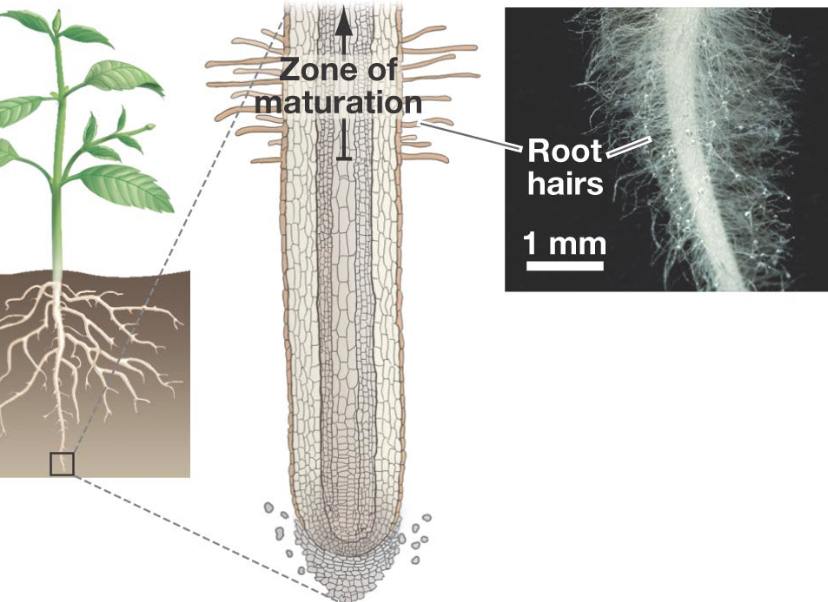
relevent tissue layers in roots
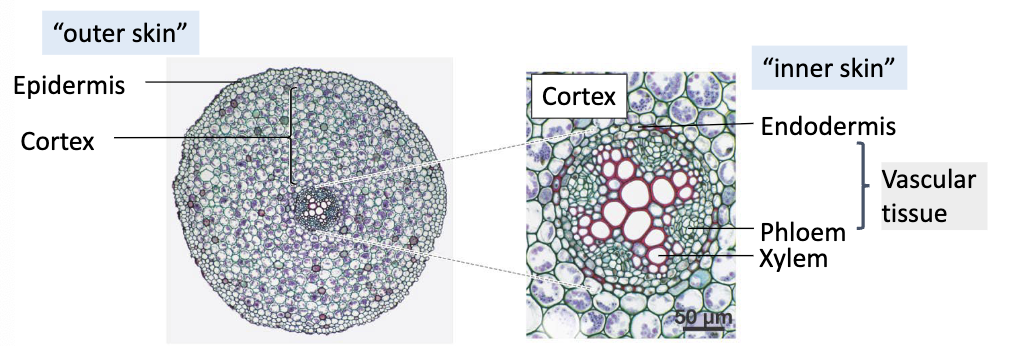
outer skin
epidermis/ epidermal cells: produces root hairs
cortex:
inner skin
endodermis/ endodermal layer:
vascular tissue: phloem & xylem (they are located in the central root tissue, in vascular bundles). to get here the H2O has to get past the other tissue layers
phloem: sugar transport
xylem: H2O transport, root—> shoot
relationship of central root tissue, vascular tissue, vascular bundles
central root tissue is everything inside the endodermis
vascular tissue is inside the central root tissue
vascular bundles are inside vascular tissue
structures/ functions/ characteristics of xylem cells that help transporting H2O (water- conducting cells)
dead cells at maturity, does not have cytoplasm/ cytosol or organelles. essentially a hollow pipe for H2O transfer
water moves by bulk flow (through soil, cell walls, through xylem)
bulk flow/ mass flow: large- scale movement of fluids driven by pressure gradients
thick secondary walls (very thick to withstand the strong -ve pressure from pulling water through xylem) and has lignin.
lignin: water-repellent, does not let water in. this forces water to go through many membranes to filter solute ions out. strengthens cell walls (red)
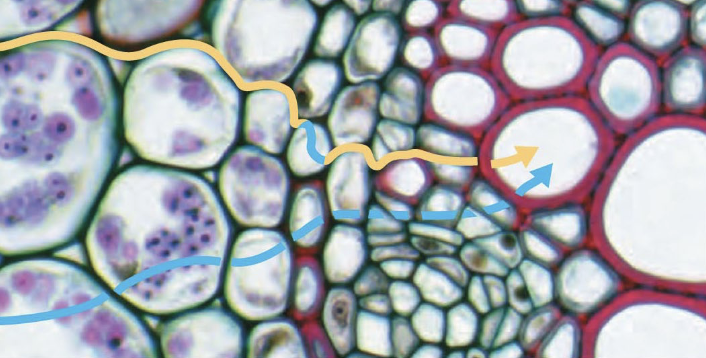
2 water- conducting cells
tracheids:
all vascular plants
long and tapered cells with pits
vessel elements:
shorter and wider with perforation plates and pits
perforation plates and pits:
NOT holes
NO lignin
H2O can flow through
thinner than cell wall
entry/exit between adjacent cells, minerals can pass through
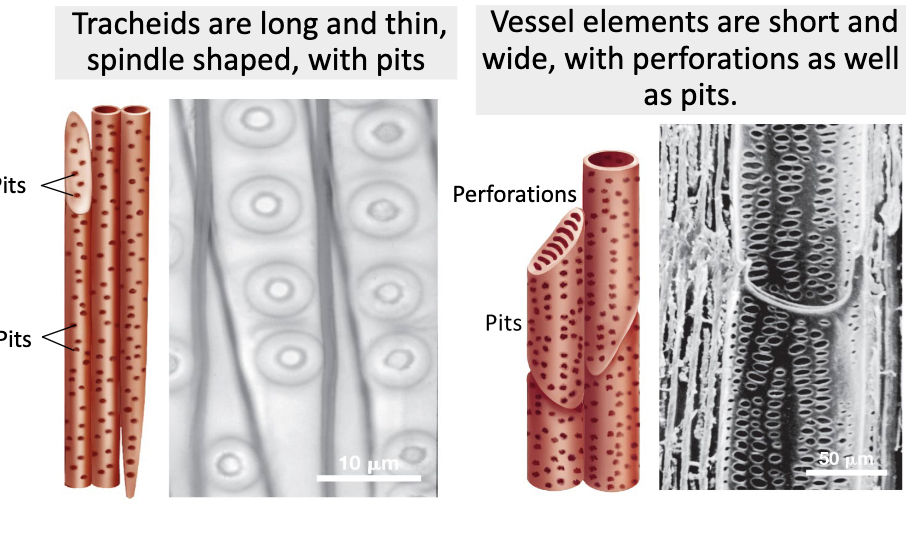
pits (relate to problem that can occur in xylem cells)
water conducting cell
in tracheids and vessel elements (xylem cells)
enable xylem loading: water and minerals are loaded into the xylem through pits
problem that can occur in xylem cells: embolism
embolism: air bubble forms in the xylem and blocks the flow of water. occurs during drought, freezing (low solubility), physical damage
pits allow the maneuvering of H2O flow
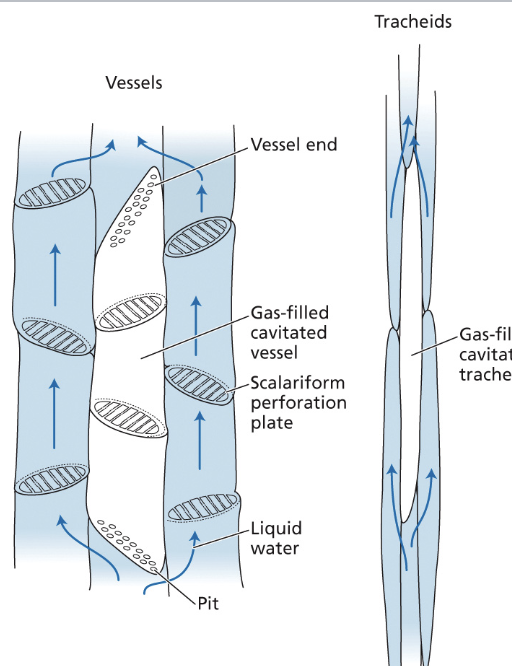
structures/ functions/ characteristics of phloem cells that help transporting H2O
pathways for movement of water into the root (3)
apoplastic pathway
symplastic pathway
transmembrane pathway
ALL move from (high H2O potential) in the soil, —> (low H2O potential) in the vascular tissue
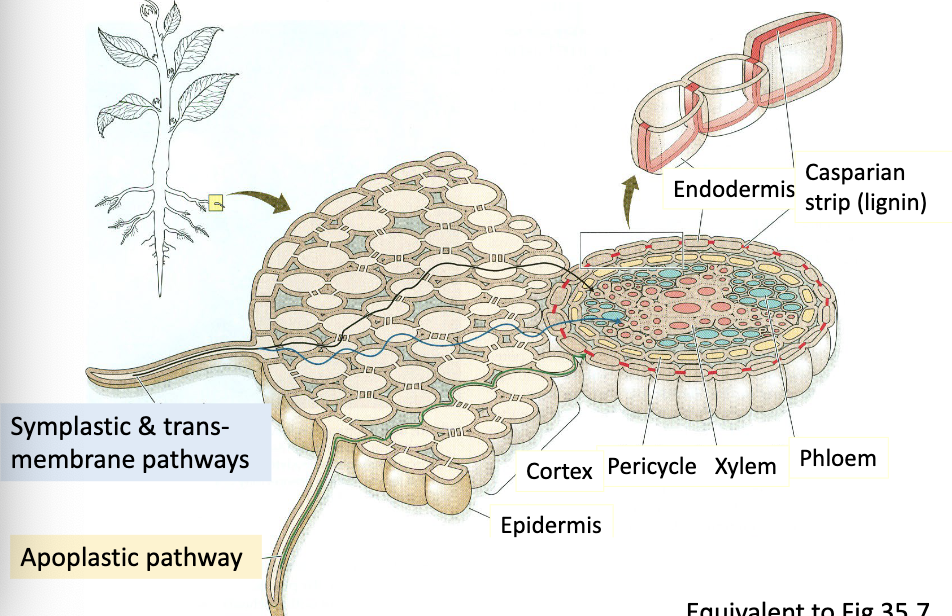
(1) pathways for movement of water into the root: apoplastic pathway
H2O is moving through only the porous cell walls until endodermal layer is reached
cell wall is EXTERIOR to the cell
never entering the cell
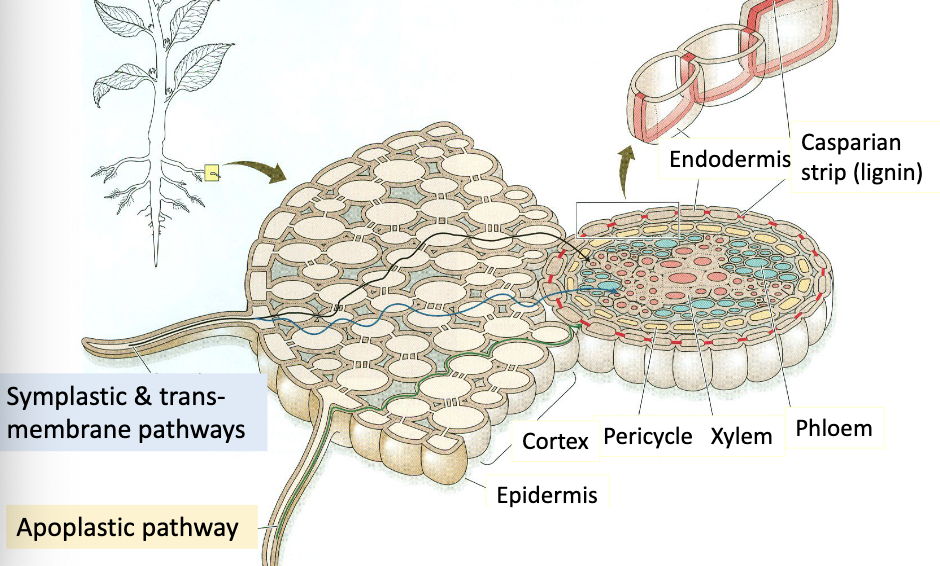
(2) pathways for movement of water into the root: symplastic pathway
moves cell- to- cell by plasmodesmata
plasmodesmata: microscopic channels that connect between cells for direct communication and transport
moves across plasma membranes
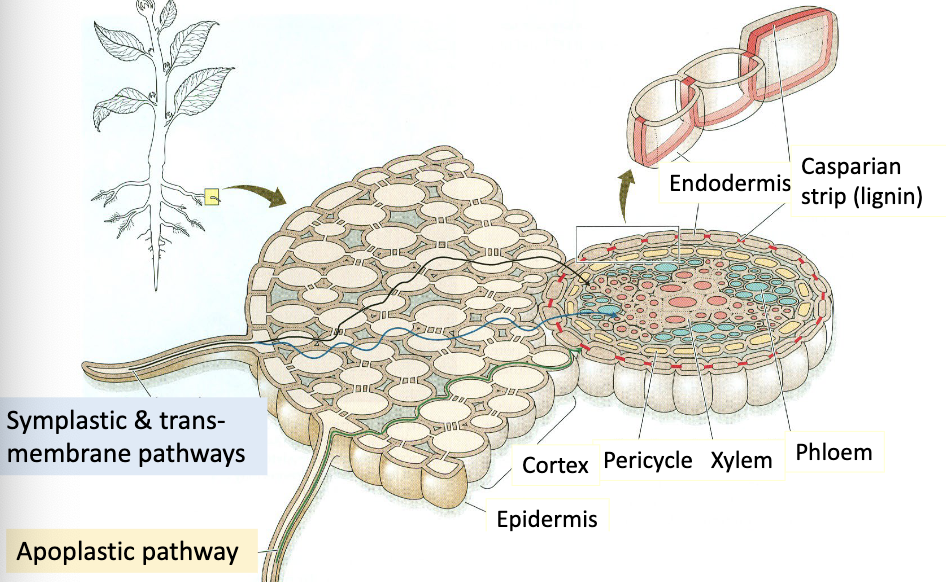
apoplastic vs symplastic transport
apoplastic: cnts cell walls allow movement of water outside of cells
symplastic: movement of water by cytoplasm
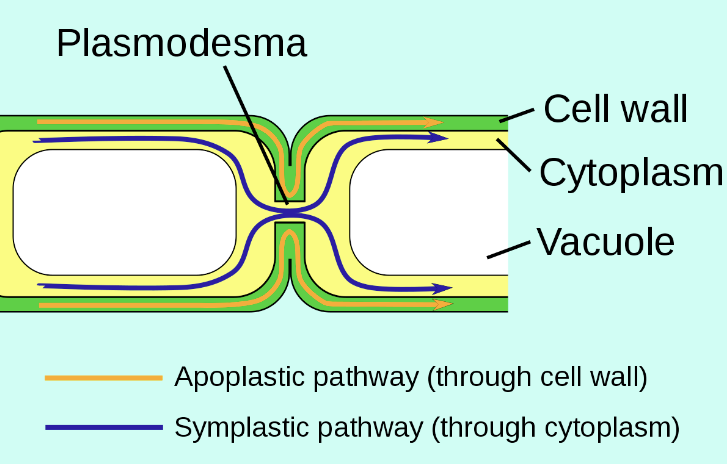
how water passes through cells in the endodermal layer
casparian strip: a continuous band of lignin in the cell walls of root endodermal cells. dark yellow
water is prevented from moving along the apoplastic pathway (cell wall), it cannot diffuse through
must enter endodermal cells by symplastic or transmembrane route
forces H2O to cross 2+ membranes to filter ions/ metals/ solvents in H2O before going to xylem vessels
lignin: strong, water repellent/ hydrophobic, found in secondary cell wall
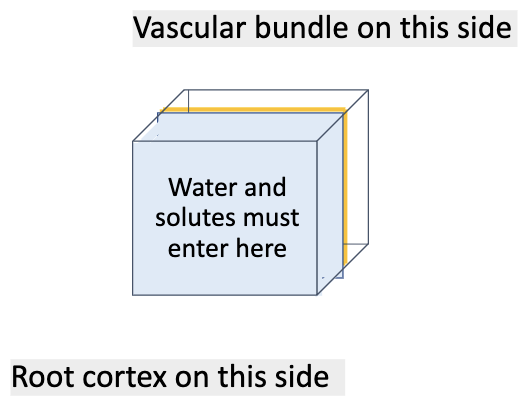
EXPLAIN
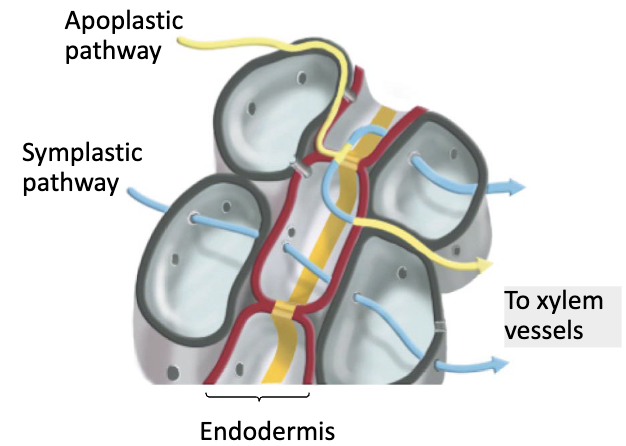
passive exclusion and endodermis
passive exclusion: non- selective, physical barrier that blocks substances based on size, charge or solubility (no E require)
large heavy metals/ toxins prevented
essential ions are actively transported
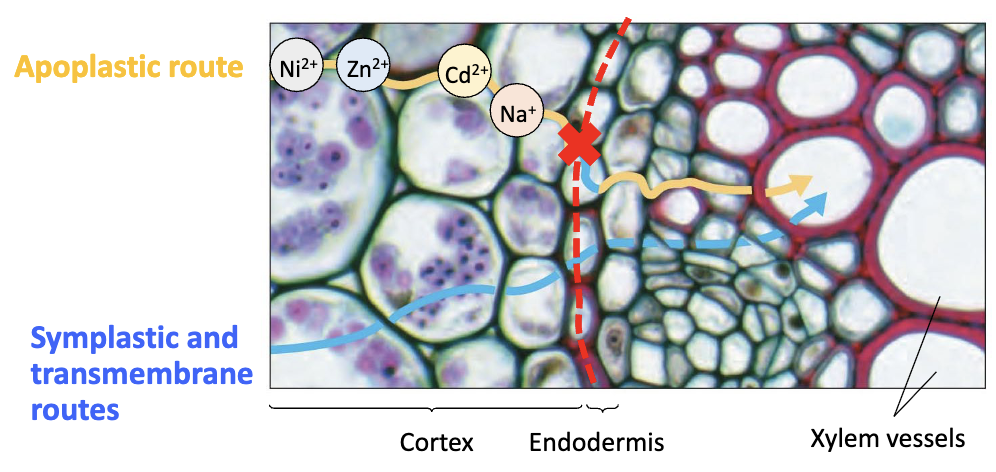
EXPLAIN
(3) pathways for movement of water into the root: transmembrane pathway
moves cell- to- cell by aquaporins
aquaporins: membrane proteins that facilitate rapid transport of water across biological membranes. found in all living organisms to maintain water balance
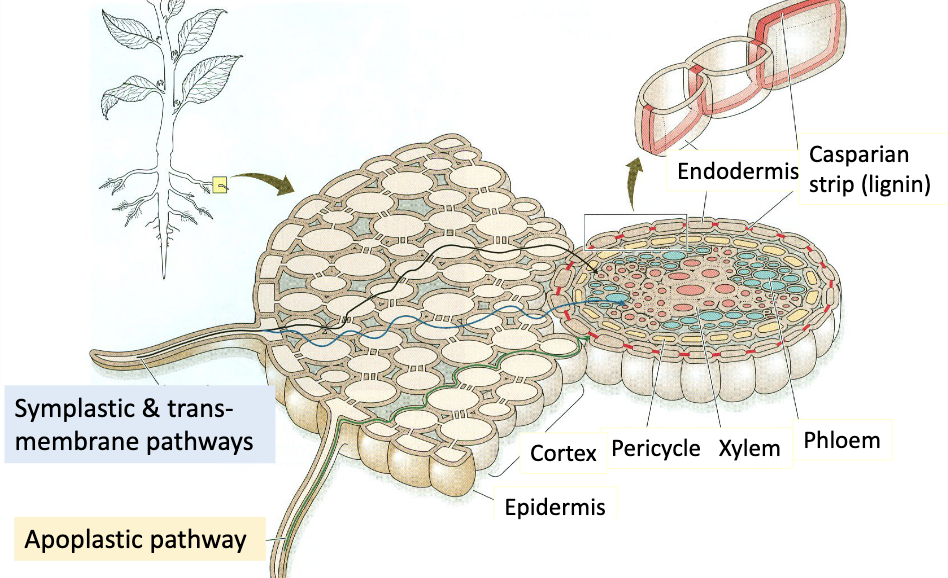
plasmodesmata vs aquaporins
plasmodesmata:
microscopic cytoplasmic channels between plant cells
in cell walls or plasma membrane of plant cells
aquaporins:
membrane- embedded proteins that form water channels
in cell membranes
how does stomata control gas exchange?
guard cells: surround stomatal pores and control if open/ closed
open: CO2 diffuse in, water vapour and O2 diffuse out
closed: minimizes water loss
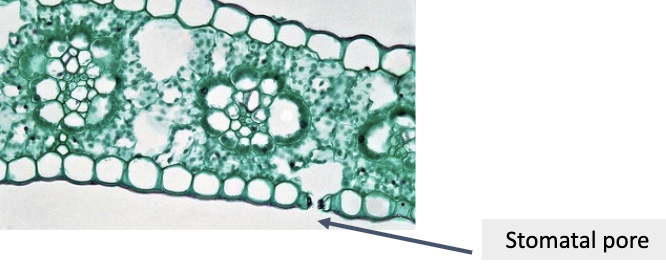
stomata open in response to light
open during the day
exception: crassulacean acid metabolism (CAM) plants stomata open at night to take in CO2
minimizes water loss
these are plants living in hot environments
(summary) (2) ways of transporting water: structire and function— the path of water through a vascular plant
what cellular structures of plants are designed and involved to regulate water transport?
how are the structure/ features of xylem cells related to their function of water transport?
water moves across the root tissue in 3 distinct pathways (apoplastic, symplastic, transmembrane)
xylem consists of tracheids and vessel elements
tracheids are long and thin, contain pits
vessel elements are shorter and wider, contain pits and perfoations
guard cells control stomatal opening and closing, diffusion of water vapour goes out of the leaf
(3) ways of transporting water: mechanisms of water transport
water moves passivly, no E needed, from roots —> leaves, along a water potential gradient
uses the difference in H2O potential to defy gravity
water at the air- water interface in leaves is under -ve pressure (tension) which pulls water up from the roots through the xylem
-ve vs +ve pressure
-ve
pressure is lower than env
+ve
pressure is higher than env
transpiration
transpiration: movement of water through the plant and subsequent evaporation (water loss) through aerial parts (leaves)
process is needed for the plant to photosynthesize
strong pull
-ve pressure/ tension
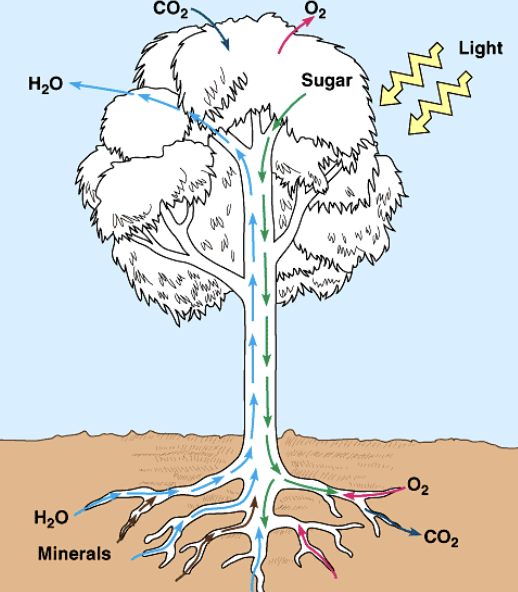
mechanisms that drive water movement through xylem over long distances (3)
root pressure
capillary action
cohesion- tension
(1) mechanisms that drive water movement through xylem over long distances: root pressure
Root pressure/ pressure potential is built up when stomata close at night and transpiration stops. the transport of mineral nutrients continues at night and decreases xylem Ψ further and increasing root pressure. therefore water moves up the xylem
push force water up xylem
mineral nutrients are actively transported into xylem
bc plant is concentrating nutrients inside cells to use in plant. needs to move against gradient
high solutes concentrations lead to decreased water potential Ψ
more solutes are being actively transported into the root, more solute= less water, water potential decreases
low Ψ drives water intake from the soil
root has low Ψ, and water goes from highΨ —> lowΨ
pressure potential is built up/ increases when stomata close at night
transpiration stops, diffusing of CO2 and H2O stop, water accumulates in the plant
transport of mineral nutrients still continue at night, this decreases xylem Ψ further and increases root pressure (+ve pressure). more nutrients = more water diffused into roots, plants accumulate more water bc it is not being released
limitation: water moves up the xylem, but not enough for tall plants

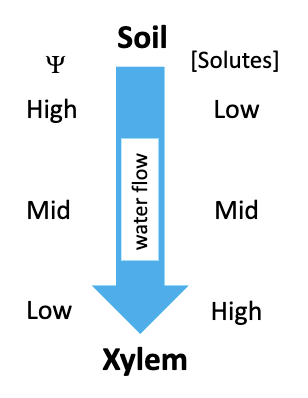
(2) mechanisms that drive water movement through xylem over long distances: capillary action/ xylem as a capillary tube
capillary tube: thin, narrow tube
xylem cells are dead at maturity, they are hollow without cytoplasm and organelles so water can move freely through them
capillary action: flow of a liquid through narrow spaces, can occur against gravity, NEEDS 3 FORCES
pulling force water up xylem
cohesion
interactions between H2O molecules (H-bonds bc of unequal distribution of e- of O and H)
upward push
adhesion
interaction with glassware, results in a curved meniscus
upward pull
surface tension
interaction of air- water, results in a curved meniscus
upward pull, works better for narrower tubes. the forces are transmitted to molecules lower down in the water column by cohesion

(3) mechanisms that drive water movement through xylem over long distances: cohesion- tension
cohesion- tension theory: explaination of how water moves upward through plants, from roots —> leaves, defies gravity
pulling force water up xylem
water evaporates in air spaces inside the leaves, in air pockets in the leaves and outside of cells
also forms a curved meniscus
water vapour diffuses through stomata out into drier air by the water potential gradient
more water evaporates from the water- air interfaces inside the leaf
as water evaporates, surface tension increases at the menisci of the air-water interfaces inside the leaf
menisci: meniscus
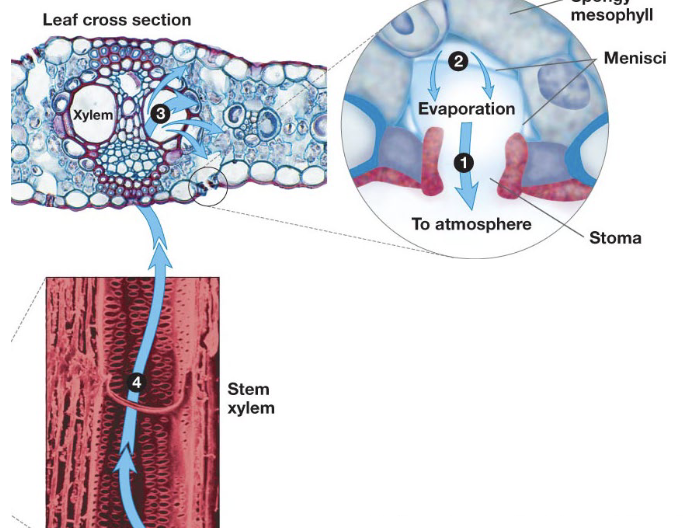
cohesion- tension theory and tension
tension:
driving force
-ve pressure in the xylem created by water evaporation in the leaves
develops at air- water interface outside of cell walls of leaf cells
when there is more curvature, there is more tension (more -ve)
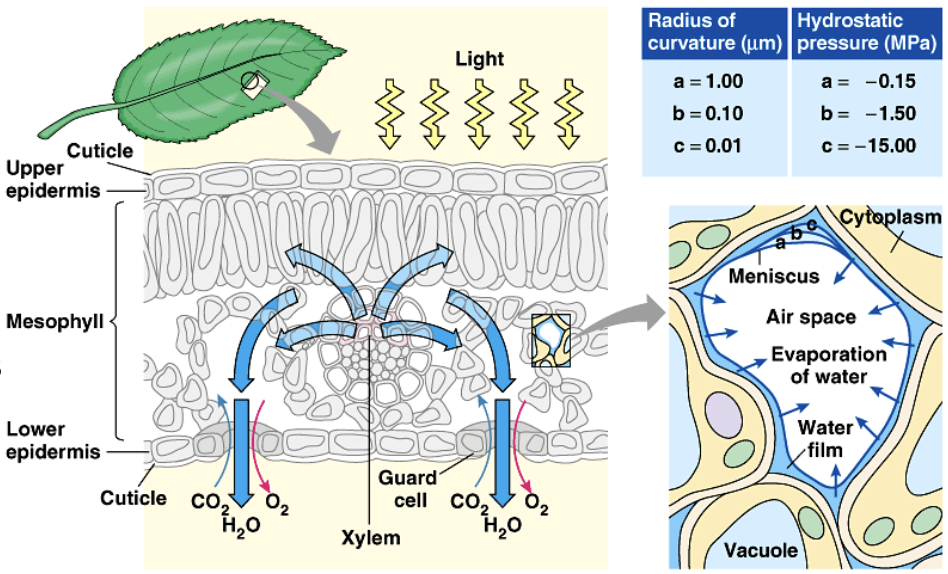
The tension from the air- water interface is transmitted from water at the interface to water in leaf cells (including leaf xylem)
Water is pulled from nearby leaf cells and xylem???
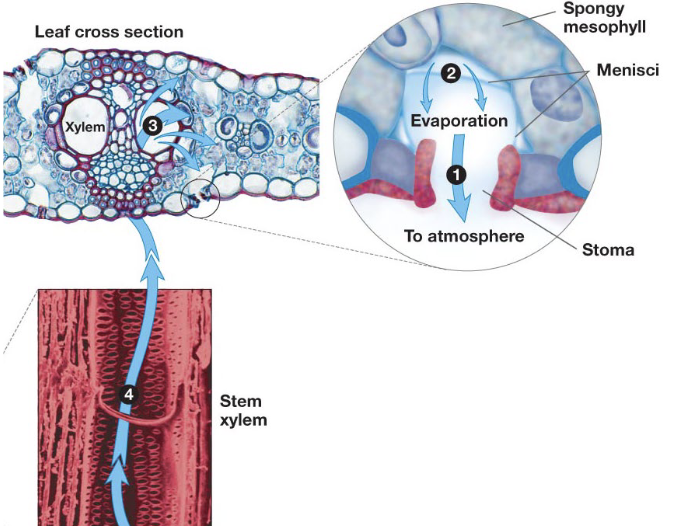
inside leaf cell walls water escapes into the air as vapour (tranpiration)
remaining water forms a curved meniscus, the curve increases surface tension and pulls on remaining H2O molecules
creates tension & -ve pressure in liquid water
tension spreads to adjacent water molecules
cohesion- tension theory and cohesion
cohesion: (between water molecules)
transmits tension from water in xylem of leaves —> stems —> roots
cnts pulling because H2O molecules are always bonded
water is pulled from the root xylem up the stem —> leaves
At the same time, mineral nutrients are being actively transported into the root, and then to the root xylem
Water from the root cortex moves into the root xylem
Water from the soil moves into the root epidermis and cortex
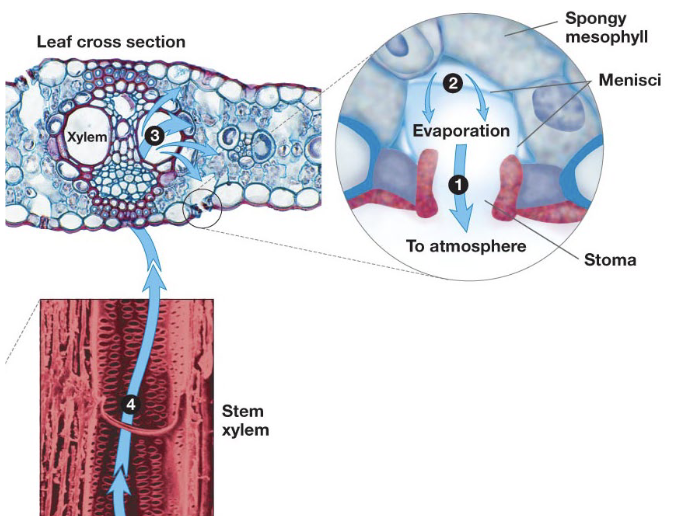
recall embolisms (now in a vascular plant)
problem that can occur in xylem cells: embolism
embolism: air bubble forms in the xylem and blocks the flow of water. occurs during drought, freezing (low solubility), physical damage
pits allow the maneuvering of H2O flow
PROBLEM OCCURING IN A VASCULAR PLANT
blocks xylem
prevents cnts column of H2O, stops H2O cohesion & pulling
forces involved in water transport
root pressure: pushing water up xylem
capillary action: pulling water up xylem (cohesion, adhesion, surface tension)
cohesion- tension: pulling water up xylem, water evaporation —> surface tension transmitted through cohesion
water potential gradient (soil- plant- air)
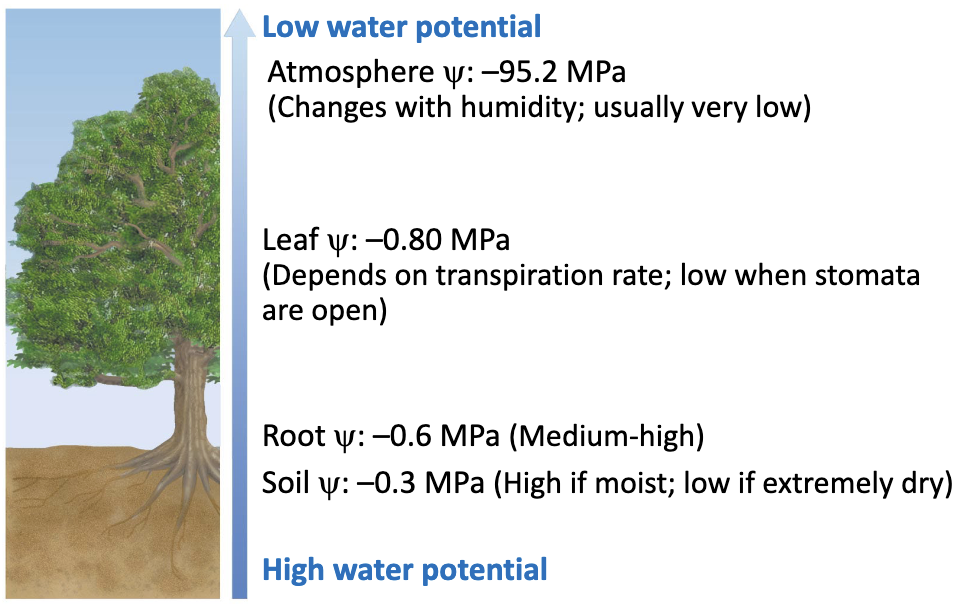
less -ve —> more -ve
soil is close to 0
h2o moves passively
water potential and relative humidity

both describe energy state of water and tendency to mvoe
drought stress
low humidity, increase Ψair negativity, faster transpiration, wilting
(summary) (3) ways of transporting water: mechanisms of water transport
what mechanisms make it possible to move water from roots to leaves?
how does the cohesion- tension theory explain the movement of water in plants?
Water moves passively from soil to roots to leaves to atmosphere,
along a water potential gradientTranspiration generates a negative pressure (tension) at the air-water interfaces in leaves, which pulls up water from the roots through xylem, due to the cohesion between water molecules
Root pressure and capillary action can result in short-distance
transport of water, but do not fully explain long-distance transport
(4) ways of transporting water: experimental evidence for the cohesion- tension theory
diff experiments
experiment 1: cut petiole
petiole: stalk connecting a leaf blade to the stem of a plant. (leaf stem)
Test: if cohesion- tension theory can explain movement of water from roots to shoots, you can cut the petiole attached to an actively transpiring leaf.
Let’s make a prediction about the direction of water movement in the part of the petiole still attached to the leaf
the water will continue to move from the petiole —> leaf because the leaf is still transpiring
experiment 2: tree trunk diameter
When under negative pressure (tension), xylem will tend to contract
...a bit like when you drink
through a straw
test: if cohesion- tension theory can explain movement of water from roots to shoots, we can measure the diameter of a tree trunk (stem).
Let’s make a prediction about how the diameter will change with changing rates of transpiration.
incr transpiration rate, induces transpiration pul/ tension on the water column
support cohesion-tension theory of long- distance water transport
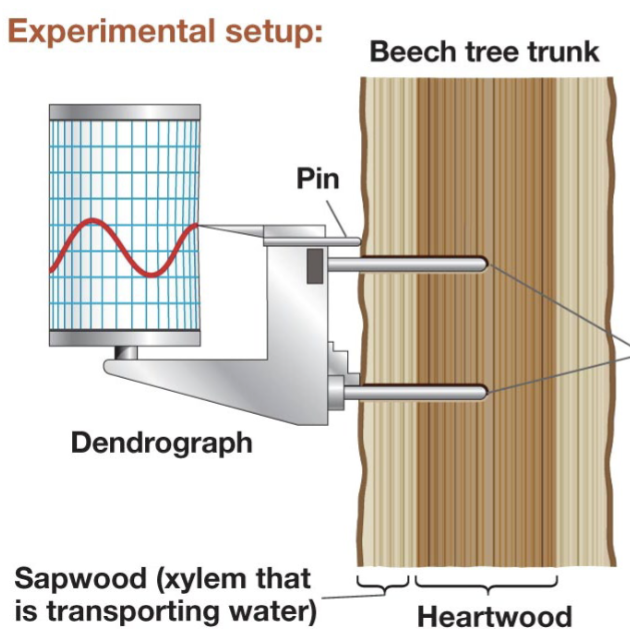
incr transpiration, incr H2O
trubk diameter shoule decr when trenspirationrate incr
experiment 3: light intensity and xylem pressure
xylem pressure: hydrostatic pressure within the xylem vessels. roles in water transport, nutrient distribution, structural support
test: if cohesion-tension theory can explain movement of water from roots to shoots, Wei et al. (1999) manipulated light levels
They knew that transpiration rates increase with increasing light intensity.
incr transpiration rate, induces transpiration pul/ tension on the water column
support cohesion-tension theory of long- distance water transport
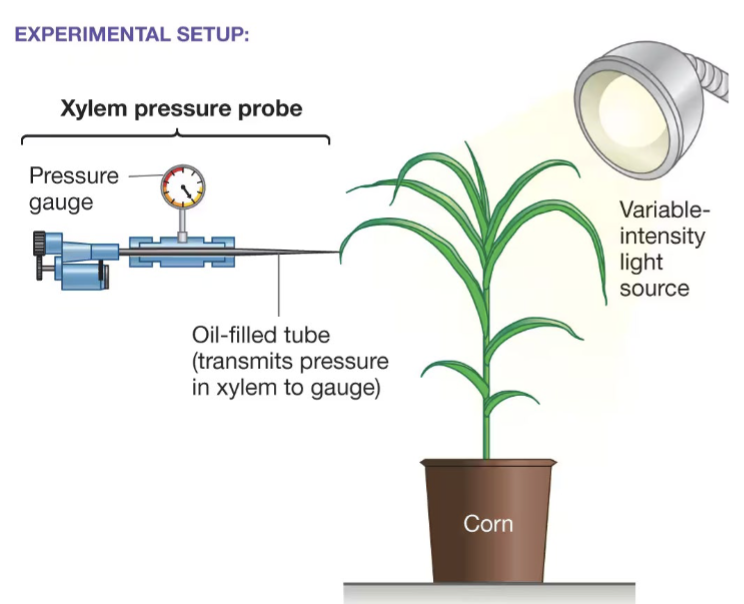
incr surface tension, incr tranpiration
incr surface tension = decr pressure
(summary) (4) ways of transporting water: experimental evidence for the cohesion- tension theory
How the cohesion-tension theory of water movement in plants is
supported by experimental evidenceHow to interpret experimental data pertaining to the cohesion tension theory
How to make predictions about relative plant transpiration rates under different environmental conditions
Experimental observations indicate that conditions favouring an
increased transpiration rate induce a transpiration pull (tension) on the water columnThese experiments support the cohesion-tension theory of long-
distance water transport
contributors for sugar transport (4)
1. Source and sink relationship
2. Structure and function of phloem
3. Phloem loading and unloading
4. Mechanism of sugar transport: pressure-flow model
(1) contributors for sugar transport: Source and sink relationship
source-sink relationship depends on developmental stages
(major) source: mature, photosynthesizing leaves
sinks: young growing leaves, flowers, fruits, seeds
growing tissue that is NOT actively photosynthesizing
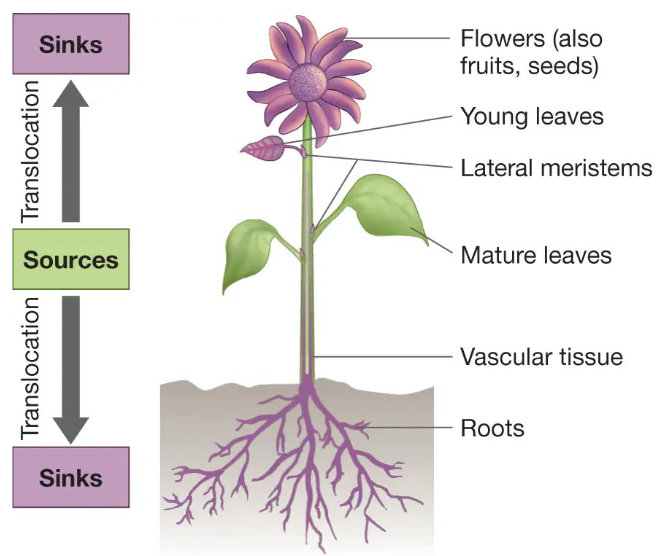
plant vascular tissues
recall// xylem (transports water) & phloem
phloem: transports sugars
both directions roots ←→ shoots. this depends on where sucrose is available
transport is from source tissues to sink tissues
source tissues: sucrose is available
sink tissues: sucrose is needed
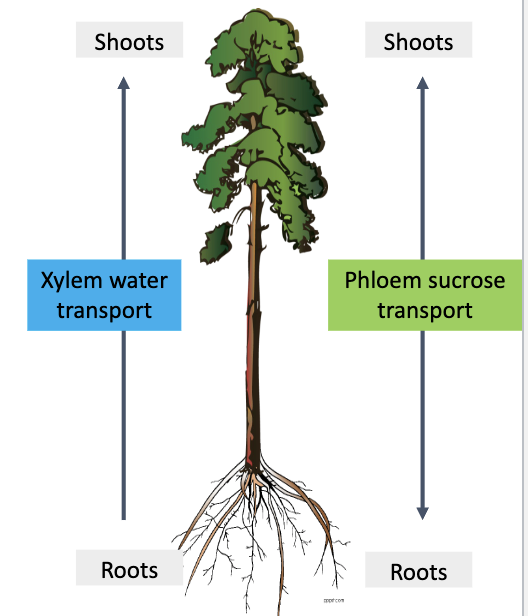
recall// transpiration, why is sugar synthesis important?
transpiration: movement of water through plant and subsequent evaporation through aerial tissues (leaves)
the process supports photosynthesis
photosynthesis produces sugars in the leaves and are translocated by phloem to other parts of the plant
for cellular function and growth
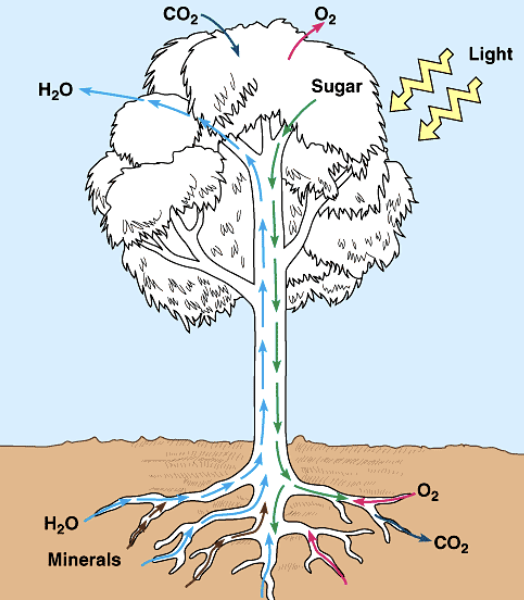
antiporters vs sumporters
membrane transport proteins that move sucrose across plant cells
differ in directionality and energy coupling
symporters:
co- transporters
move sucrose + other molecule in the same direction
powered by a pre-established electrochemical gradient
load sucrose into phloem from leaves, and uses proton gradient from ATPase pumps
antiporters:
exchangers
move sucrose in one direction, other molecule in the other direction
indirectly ises gradients
regulate sucrose storage/ release
summary: (1) contributors for sugar transport: Source and sink relationship
How the direction of transport of sucrose is determined in plants
The source-sink relationship in plants
In vascular plants, sugars can move in both directions between roots and shoots
Sugars are moved from source tissues to sink tissues (direction will depend)
(2) contributors for sugar transport: structure and function of phloem
recall// other vascular tissue xylem: DEAD @ maturity, just a cell wall
phloem consists of : ——————> ALIVE @ maturity
sieve- tube elements (SE):
no organelles & nucleus, but alive
sugar- conducting cell
sieve plates: perfoorated connections between sieve tube elements
companion cells (CC):
contain organelles (filled space) & nucleus
responsible for metabolic needs of sieve- tube elements
involved in loading and unloading of sucrose
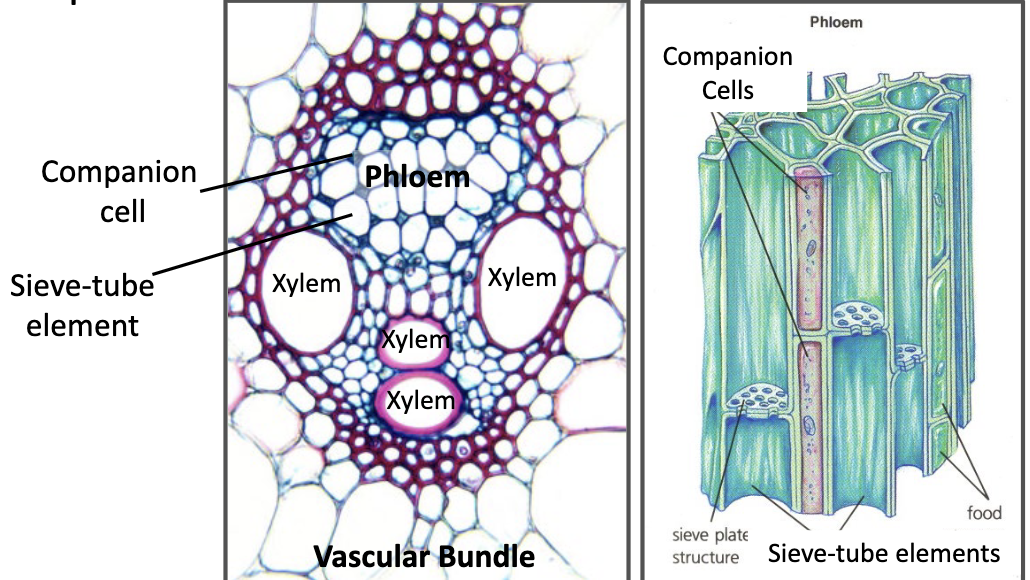
phloem: how sieve- tube elements relate to companion cells
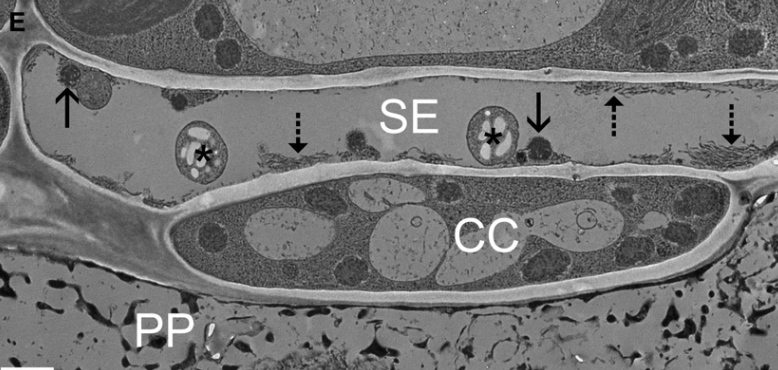
Sieve-tube element (SE), with residual organelles
Companion cell (CC) and SE are connected via plasmodesmata
PP: phloem parenchyma cells (storage role)
xylem cells vs phloem cells
Feature | Xylem | Phloem |
|---|---|---|
Function | Transports water + minerals (upward, roots → leaves) | Transports sugars + nutrients (bidirectional, leaves → roots/fruits) |
Direction of Flow | Unidirectional (upward only) | Bidirectional (up and down) |
Cells Involved | Dead at maturity (tracheids, vessel elements) | Alive at maturity (sieve tubes, companion cells) |
Cell Walls | Thick, lignified (for strength) | Thin, non-lignified |
Pressure Mechanism | Cohesion-tension (transpiration pull) | Pressure flow (osmotic pressure gradients) |
Energy Requirement | Passive (no ATP needed) | Active (requires ATP for loading/unloading sugars) |
Speed of Transport | Fast (up to 45 m/hour) | Slow (~1 m/hour) |
Appearance | Hollow, rigid tubes (visible as "wood grain") | Soft, flexible tissue (e.g., inner bark) |
summary: (2) contributors for sugar transport: structure and function of phloem
What plant cells are involved in sugar transport?
How is the structure of phloem cells related to its function of sugar transport?
Sugars are translocated from source to sink via the phloem tissue
Phloem consists primarily of sieve-tube elements, and companion cells
Sieve-tube elements are long, thin cells with perforated ends (sieve plates); they lack most organelles, which facilitates sugar translocation
Companion cells are connected to sieve-tube elements by plasmodesmata, and help maintain the metabolic activity of sieve tube elements
Companion cells are important in sucrose loading and unloading
(3) contributors for sugar transport: phloem loading and unloading
loading: transfer of sugars from source tissues to the phloem, where they are concentrated
unloading: transfer of sugars from phloem to sink tissues
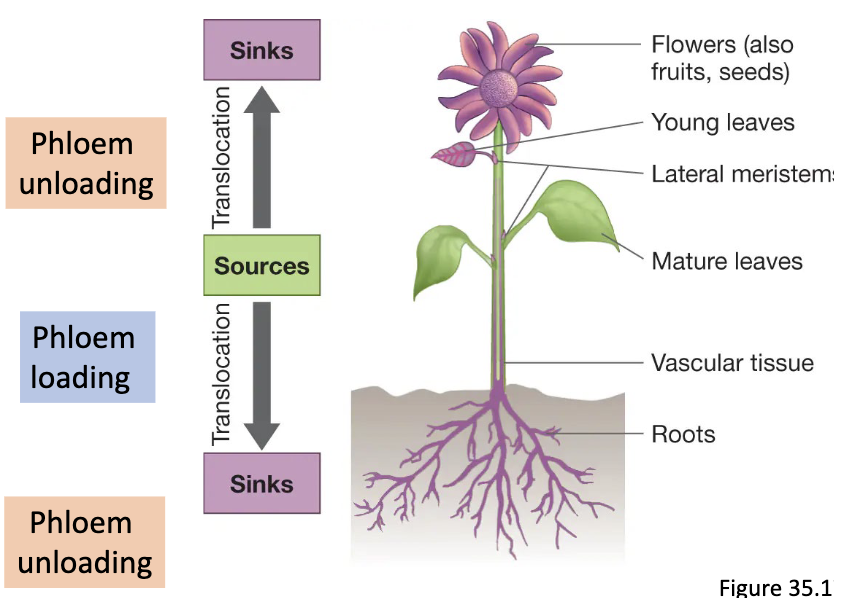
phloem loading: sugar transport photosynthetic cell —> phloem
photosynthetic cell: plant cell that has chloroplasts to convert light E —> chemical E through photosynthesis
how? steps? results?
(SECONDARY) Active transport moves sucrose from photosynthetic source cells into companion cells (steps)
Once in companion cells, sucrose builds up in sieve-tube element cells via diffusion
want to keep sucrose in phloem, so particles from source cells —> companion cells/ sieve- tube elements are moving against the conc gradient
ATP is used to accumulate high [H+ ] outside the cell into source cell with a proton pump protein
as H+ particles move back down its conc gradient into companion cell, it brings a sucrose molecule from the source cell
This establishes an electrochemical gradient that allows the transport of sucrose into the phloem cell against a [sucrose] gradient
secondary active bc ATP is used INDIRECTLY, 2 step process
active bc it uses H+ and moves it across a membrane against its electrochemical gradient
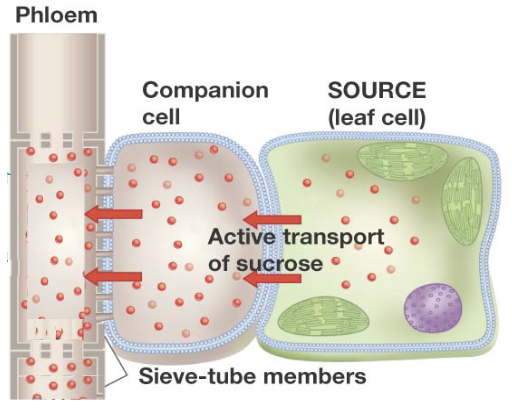

(results)
High [sucrose] in the sieve-tube element leads to low solute potential (Ψs )
Water flows in from adjacent xylem (high —> low Ψ)
This increases turgor pressure in the phloem near the source
phloem unloading: sugar transport from phloem to sink cell
Near the sink tissue, sucrose can be exported from phloem to sink cells by facilitated diffusion or active transport
This decreases [sucrose] in sieve tube elements and increases
water potentialWater moves out of the phloem and into the xylem tissue, decreasing turgor pressure
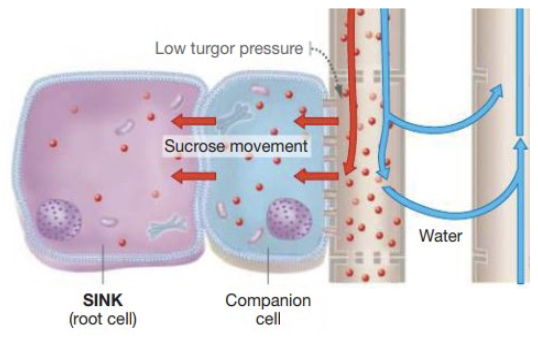
whole picture: phloem loading and unloading
pressure- flow hypothesis
leads to a pressure potential gradient in phloem
high turgor pressure near source tissue, low turgor pressure near sink tissue
water moves down pressure gradient, sugar is transported by bulk flow
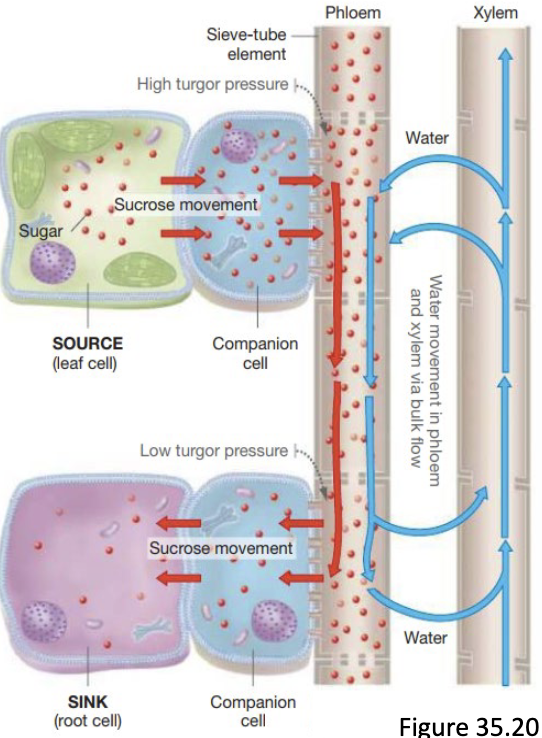
metabolically active sink (facilitated diffusion)
Phloem unloading into growing sink tissues (e.g., new leaves, elongating roots)
In growing cells, sucrose is rapidly depleted by metabolic activity, maintaining low [sucrose]
uses sucrose and keeps the conc gradient
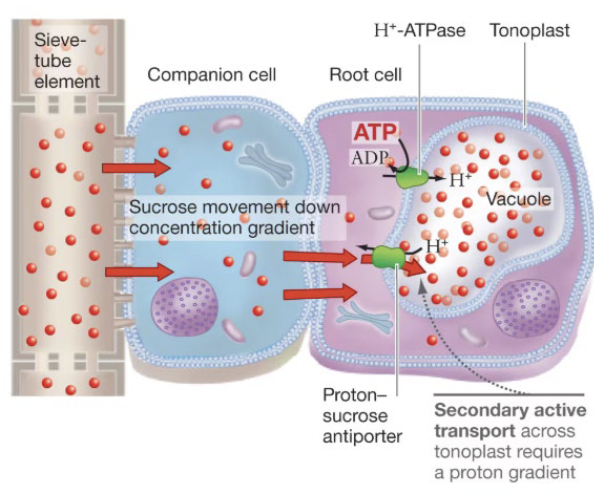
storage sink (active transport)
in vacuole, active transport is needed
Sucrose accumulates in storage cells
To maintain a favourable [sucrose] gradient for continued uptake from companion cells, sucrose must be actively transported to the vacuole
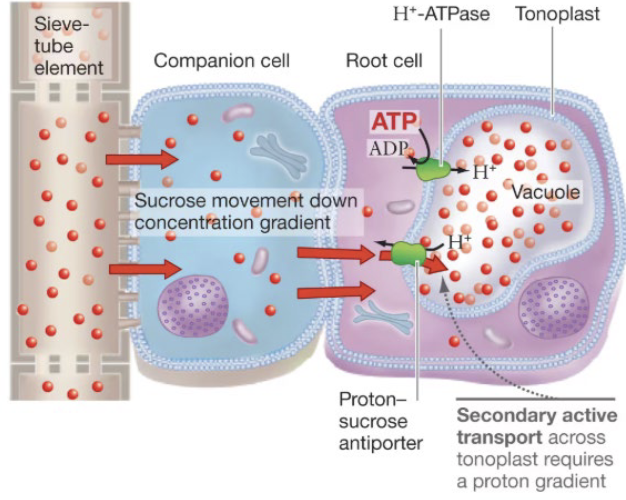
summary: (3) contributors for sugar transport: phloem loading and unloading
How do plants regulate phloem loading and unloading?
How do plants control the capacity of sink tissues to accept sugars?
Sugars move from source to sink by water moving down a pressure gradient; sugars are transported by bulk flow
Vascular tissues are organised into vascular bundles; the xylem can thus provide water needed for bulk flow in the phloem
Sink capacity is controlled by:
Using sucrose in metabolically active tissues
Storing sucrose in vacuoles in storage tissues
(4) contributors for sugar transport: mechanism of sugar transport: pressure- flow model
concept: pressure- flow model
Source: high [sucrose] and water flow into the phloem generate high turgor pressure
Sink: low [sucrose] and flow of water out of the phloem generate low turgor pressure
Bulk flow: transport of sugars from source to sink is due to the difference in turgor pressure
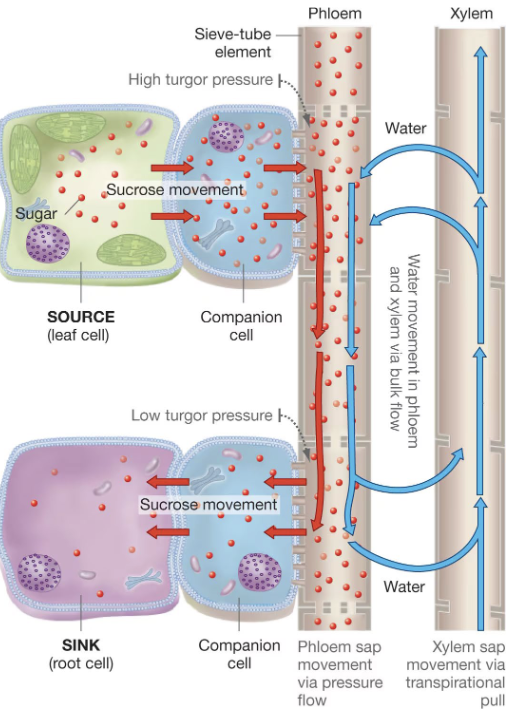
evidence for pressure- flow model
this bug is essentially a tube for plant liquid
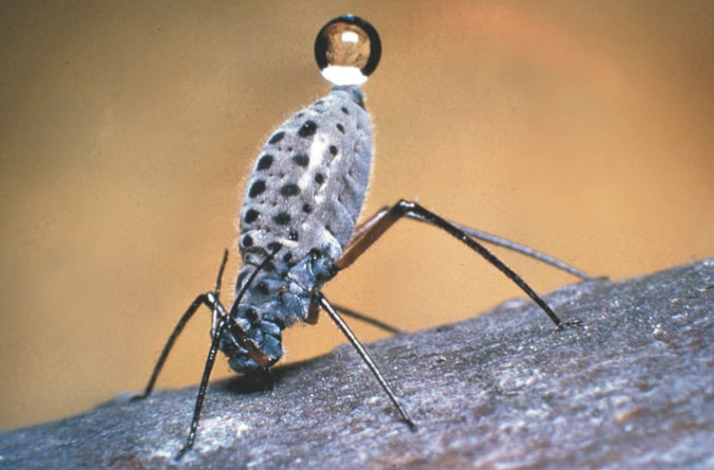
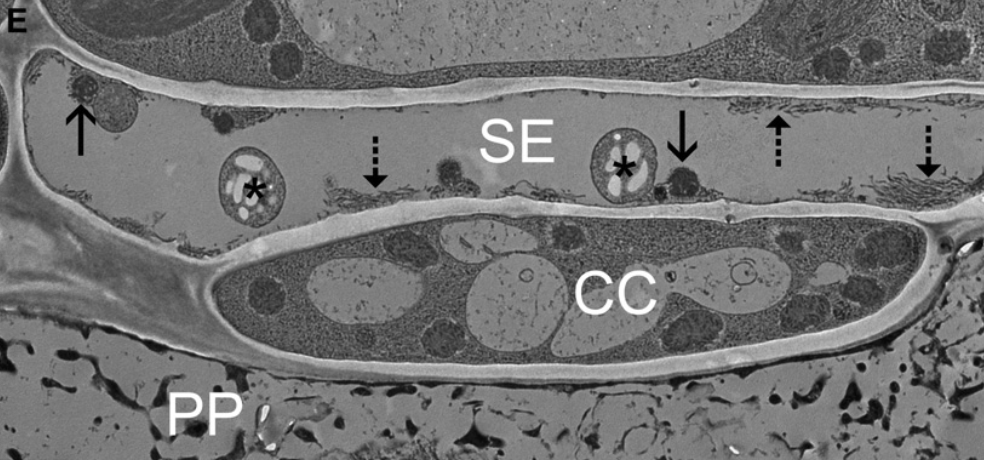
summary: (4) contributors for sugar transport: mechanism of sugar transport: pressure- flow model
How the pressure-flow model explains sugar translocation in the
phloemHow the pressure-flow model is supported by evidence
The pressure-flow model of sugar transport involves the generation of high turgor pressure in phloem due to high [sucrose] in the sieve-tube element near the source
The bulk flow transport of sugars from source to sink is due to the
difference in turgor pressure